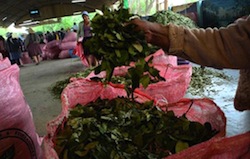Bolivia's Overflowing Coca Deposits Raise Debate
November 13, 2015 - insightcrime.org
Written by Arron Daugherty
Bolivia's confiscated coca stores are at capacity
 A debate on what to do with Bolivia's overflowing stores of seized coca highlights the Andean nation's unique relationship with the leaf and its approach to combating drug trafficking.
A debate on what to do with Bolivia's overflowing stores of seized coca highlights the Andean nation's unique relationship with the leaf and its approach to combating drug trafficking.
Bolivian officials are saying the country's deposits for confiscated coca have reached their maximum capacity of 3 million pounds, reported La Razon.
Much of this storage space is rented, placing a burden on the budget of Bolivia's General Directorate of Coca Leaf and Industrialization (Digcoin). The head of Digcoin, Ricardo Albino Paniagua, has suggested either burning or composting the stored coca on military land.
However, government officials have already voiced their opposition to the prospect of burning coca.
"We can't burn it because of its sacred character," Rural Development Minister Cesar Cocarico said during a press conference. The minister agreed with the idea of composting seized coca leafs, but admitted it would take a lot more time and effort than burning them.
Paniagua noted that previous composting projects have been unable to keep up with the quantity of seized coca.
InSight Crime Analysis
Bolivia's debate on how to dispose of the confiscated coca highlights the leaf's unique place in Bolivian society.
While it is common to think of coca only as the essential ingredient used to make cocaine, the plant has been cultivated in Bolivia since the time of the Incas and is used for a host of medicinal, nutritional and religious purposes. An estimated 30 percent of all Bolivians chew coca on a regular basis. Bolivia's President, Evo Morales, was once a coca farmer himself and head of the country's coca growers federation.
As a result, Bolivia's anti-drug policies look significantly different than those of the world's other main coca producers, Peru and Colombia. Bolivia currently allows 12,000 hectares of coca to be cultivated for traditional domestic markets and forbids eradicating illegal coca crops with herbicides and aerial fumigation. In contrast Colombia, the world's biggest coca producer, only recently stopped aerial fumigation.
Regulating coca production is arguably easier in Bolivia than in Colombia and Peru, where much of the coca is sown in territories controlled by armed rebel groups. Still, it is worth noting that Colombia is forecast to see its second straight year of dramatic increases in cultivation, while United Nations statistics show Bolivian production of the leaf is at its lowest in over a decade.